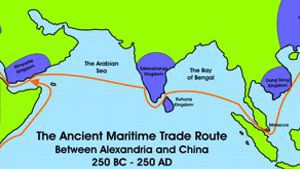
Chinese Texts
Through out Chinese history, Chinese explorers, ambassadors, and merchants made occasional trips to the western world. Many of their reports were written down. The Chinese text, however, that is of real importance to us is one known as Xiyu chuan (“Chapter on the Western Regions”) taken from Hou Han shu 88. The Hou Han shu, the official history of the Later (or ‘Eastern’) Han Dynasty (25-221 CE), was compiled by Fan Ye, who died in 445 AD. Fan Ye used a number of earlier histories, including the Shi ji by Sima Qian and the Han shu by Ban Gu plus many others (including some that were also entitled Hou Han shu), most of which have not survived intact. The particular chapter in his History of China, of interest to us covers 25 - 55 AD. John Hill has recently completed the translation of this text, and has even made it available over the Internet, complete with his notes. We wish to thank John for the contribution he has made to ancient study, and to this part of Nabataea.Net. Discussion of this text has been taking place on the Nabataea.net Discussion Board. Below are some links that will provide you with more information.
The Xiyu chuan (“Chapter on the Western Regions”) from Hou Han shu 88 (25-55 AD) Translated by John E. Hill. This is the key text from which we can learn about the Arab world from a Chinese perspective. Possible name places include: Gerrha, Petra, Kerak, al-Jauf, and perhaps, Leuce Come.
You can access John Hill’s research by clicking on the link below and visiting the University of Washington’s Web Page: http://depts.washington.edu/uwch/silkroad/texts/hhshu/hou_han_shu.html
Another good book to read is China and the Roman Orient by Friedrich Hirth (1875) and republished recently by Ares Publishers in Chicago.
An excellent French book is: “*Les pays d’Occident d’après le Heou Han chou*” in T’oung pao 8 in T’oung pao 8 by Édouard Chavannes, (1907) Many of Chavannes’ notes are out of date. John Hill’s translation of the Chinese texts and accompanying notes are more up to date.
An annotated translation of Chapters 61 and 96 of the Han shu by A. F. P. Hulsewé‚ and M. A. N. Lowe is available in China in Central Asia, Leiden, E. J. Brill, 1979 (including detailed notes on the identification of many place-names also found in the Hou Han shu), The Roman Empire in Chinese Sources by D. D. Leslie and K. H. J. Gardiner, Bardi Editore, Roma, 1996 contains translations of almost all of the relevant texts relating to the Roman Empire accompanied with copious notes but, unfortunately it is rather hard to find, and does not include the Chinese originals. It does, however, contain material unavailable elsewhere in English and is a useful reference.
Another good source is: Records of the Grand Historian of China: Translated from the Shih chi of Ssu-ma Ch’ien by Burton Watson, Columbia University Press, New York and London, 1961. (Check out chapter 123: The Account of Ta-yüan, on pp. 264-289)
The Li-Kan Question
Copyright © 2002, John Hill
The question of the identification of the name “Li-kan” in early Chinese texts has preoccupied scholars for well over 100 years. It was, I believe, F. Hirth in his book, “China and the Roman Orient” who first proposed that it might refer to Petra (as a Chinese transcription of the Arabic name “Rekem” which, like “Petra” signifies “Rock”). The alternate suggestions since then have been legion - an excellent summary of them may be found in the indispensable book by A.F.P. Hulsewe and M.A.N. Loewe, “China in Central Asia : the Early Stage : 125 B.C.- A.D. 23” Leiden. E.J Brill. 1979, p. 117, n. 275.
It seems to be pretty generally accepted now that Li-kan did not represent Petra but stood for some or all of the Seleucid empire and was later used to designate those territories taken over by the Romans.
There is, however, a 3rd century Chinese text, the Wei lue, which does seem to mention Petra and a number of other Nabataean sites and routes. Many of the identifications of place names require long and complex arguments to establish. Some of them are based on Chinese attempts to transcribe local names, while others are mainly descriptive in character.
You can read the Wei lue texts and my accompanying notes by following the links on the China Text page of Nabataea.net.
If you or any of your readers have particular questions about any of them please feel free to contact me directly at: [email protected] and I will do my best to answer them.

John Hilll Through the jade Gate
Trade in the Far East
In 1027 BC the Chou came to power in northern China. Their dynasty lasted more than 800 years until 221 BC. During this time, Chinese rule was extended and there was increased trade with other nations. The Chou Dynasty was replaced by the Han Dynasty (202 BC - 220 AD), which is sometimes referred to as the greatest of all Chinese Dynasties. By 200 BC the Chinese culture had produced excellent craftsmen whose products were prized because of their beauty and speciality. Chief among these were products made of silk. During this period only China produced silk, which was exported to places as far away as Rome. Other Chinese exports included spices such as cassia and ginger, iron and jade.
From the earliest times, China conducted trade with Korea, both on land and by sea. From 140 BC regular trade fairs were held on the northern Chinese frontier, where furs and other valuable merchandise from Korea could be bought. Korean ships traveled along the coast, around the northern coast of the Yellow Sea to ports along the Shantung Peninsula, while others crossed the open sea to Nagasaki (Japan).
Farther south, China conducted trade using Chinese ships known as junks. These carried cargoes along the coast from Canton to to Haiphong (today northern Vietnam). Junks left Haiphong and Foochow to travel via the Philippines to the Moluccas (Spice Islands) and to east Java. The journey took several months, and trade was mostly in cloves, nutmeg and mace.
From as early as 200 BC Chinese junks sailed to the Malay Peninsula and through the Strait of Malacca. There they met and traded with the Indonesian people and with merchants from east India.
It is interesting to note that the Han Dynasty conducted distant trade at the same time that the Nabataeans conducted sea trade. Both of these civilizations rose to power about the same time, and both of them waned at the same time.Interestingly enough, the Dong Son culture in North Vietnam (150 BC - 50 AD) corresponds to roughly the same time, which rose to prominence because of international trade of goods and ideas.

Map of Far East Trade Routes
During the time of the Han Dynasty, Chinese products, such as silk reached the Roman Empire. Nabataean merchants not only traded in silk, but began to manufacture silk products in both Damascus and Gaza, known as Damask and Gauze silk products. Some historians have speculated that the rise in international trade during the period of 200 BC to 200 AD helped the Asian and Arabian civilizations rise to great heights, and acquire great wealth.
Chinese Contact with the West
(as mentioned in Chinese historical sources)
|
|
|
|
| Shih Chi, ch. 123 | 90 BC | 100 BC |
| Chien Hans Shu, ch. 96a | 100 BC | 100 BC |
| Hou Han Shu, chs. 116,118 | 450 AD | 97 AD |
| Wei Lueh in San Kuo Chih, ch. 30 | Before 429 AD | 220 - 264 AD |
| Chin Shu, ch. 97 | 635 AD | 265 - 419 AD |
| Sung Shu, ch. 97 | 500 AD | 420 - 478 AD |
| Liang Shu, ch. 54 | 629 AD | 502 - 556 AD |
| Wei Shu, ch. 102 and Pei Shih, ch. 97 | 572 AD | 386 - 556 AD |
| Thang Shu, Chiu ch. 198 | 950 AD | 618 - 906 AD |
| Thang Shu, Hsin, ch 221, a,b | 1061 AD | 618 - 906 AD |
| Nestorian Stone | 781 AD | 719 AD |
| Sung Shih, ch. 490 | 1345 AD | 960 - 1279 AD |
| Chu Fan Chih | 1225 AD | 1225 AD |
| Ming Shih, ch. 326 | 1739 AD | 1368 - 1643 AD |
Chart is adapted from material presented in Science and Civilisation in China, Joseph Needham, Vol. I, Cambridge University Press, 1954, Page 192-193
























Page Discussion
Membership is required to comment. Membership is free of charge and available to everyone over the age of 16. Just click SignUp, or make a comment below. You will need a user name and a password. The system will automatically send a code to your email address. It should arrive in a few minutes. Enter the code, and you are finished.
Members who post adverts or use inappropriate language or make disrespectful comments will have their membership removed and be barred from the site. By becoming a member you agree to our Terms of Use and our Privacy, Cookies & Ad Policies. Remember that we will never, under any circumstances, sell or give your email address or private information to anyone unless required by law. Please keep your comments on topic. Thanks!